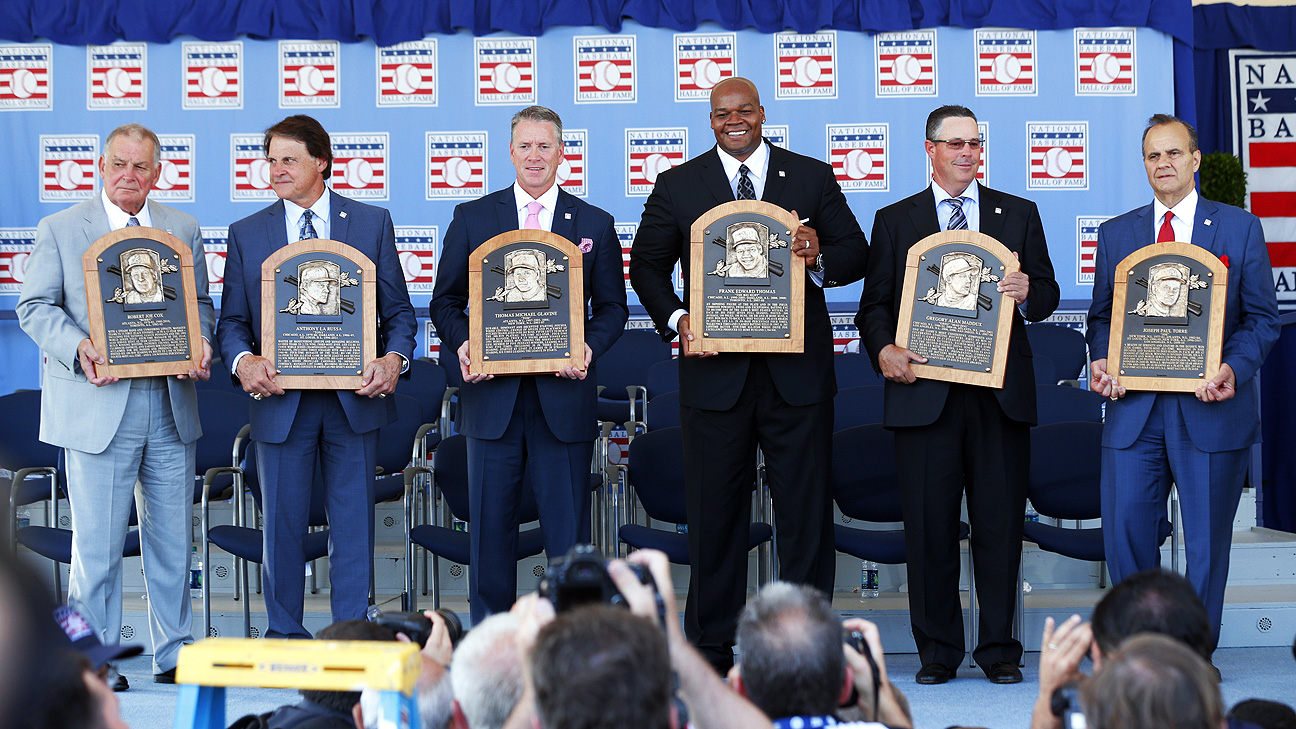July 27, 2014 – A Legendary Hall of Fame Class
The 2014 Hall of Fame class is one of the most dominant in history. The players selected off the ballot are comprised of some of the best hitters and pitchers of the modern era, and the three managers selected by the Veteran’s Committee are some of the most successful in history.
In this group of Greg Maddux, Frank Thomas, Tom Glavine, Tony La Russa, Bobby Cox, and Joe Torre, their combined accomplishments are astounding:
11 World Series Championships, 6 Cy Youngs, 3 MVPs, 10 Manager of the Year Awards, 19 Gold Gloves (18 of which belong to Maddux), 8 Silver Sluggers, and 32 All-Star Selections.

(AP Photo/Mike Groll)
It’s important to recognize the individual greatness of each player.
During their careers, Maddux and Glavine found their greatest success as members of the ’90s Braves rotation, regularly battling each other for the title of best pitcher in the National League. In fact, Maddux and Glavine finished No. 1 and No. 2, respectively, for most wins in the ’90s. Maddux’s peak from ’92 to ’98, during the beginning of the Steroid Era, was one of the best ever.
During this period, he won four consecutive Cy Young Awards while averaging a 2.15 ERA/190 ERA+, 0.968 WHIP, and 4.78 SO/W over 239 innings each year. Glavine, from ’91 to ’00, posted a 3.13 ERA/134 ERA+ with five 20+ win seasons, two Cy Youngs, and he finished as a runner-up and third-place finisher two more times each—often losing to Maddux.
Meanwhile, Thomas was wreaking havoc on American League Pitchers. From ’90 to ’00 Thomas averaged a .321/.440/.579 line with a 169 OPS+, 31 HR, 108 RBI, and 108 BB to 76 SO. In fact, Frank Thomas had one of the best starts in history with the 5th highest wRC+ of any hitter through their age-29 season ever (better than Lou Gehrig, Mickey Mantle, Mike Trout, Albert Pujols and many more).
Each of the managers—La Russa, Cox, and Torre—had at least 2,000 wins and their combined managerial record is 7,558 – 6,363 (.543 win %). All three managers had their own respective dynasties. La Russa helped bring the Athletics to three consecutive World Series from ’88 to ’90. He then saw consistent success and multiple championships during his run managing the Cardinals from ’96 to ’11. Cox helped lead the Braves to a record 14 consecutive division titles, including five NL Pennants and a World Series win. And Torre’s Yankees made the playoffs every year from ’96 to ’07, at one point winning four World Series championships in only five years.
From ’88 to ’06, there were only four World Series that did not feature at least one of these three as a manager (’93, ’97, ’02, and ’05).
While La Russa and Cox were below-average players, Torre was a great hitter in his own right. Over his 18-year playing career, Torre accumulated 62.3 fWAR with a slash line of .297/.365/.452 (129 wRC+). He even won an MVP in ’71 when he led the league with 230 hits, 137 RBIs and a .363 batting average.
It will be a long time before we see a Hall of Fame class with a similar combination of such greatness on the field and in the dugout.
July 28, 1991 & July 28, 1994 – Dennis Martinez & Kenny Rogers’ Perfect Games
Dennis Martinez and Kenny Rogers were both four-time All-Stars who never finished above 5th-place in Cy Young voting. They both played for over 20 years, garnering over 200 wins, and retiring in their 40s. On July 28—exactly three years apart—they both joined elite company by becoming the 13th and 14th pitchers in baseball history to throw a perfect game.
These two games saw both pitchers toss their perfectos against teams from the greater Los Angeles metropolitan area (Martinez beat the Dodgers and Rogers did so against the Angels). Also, Martinez and Rogers are the most recent pitchers in Expos’ and Rangers’ history, respectively, to throw a no-hitter.
Martinez’s game was notable for a couple of reasons. His feat made him the first non-American-born pitcher to throw a perfect game. His catcher, Ron Hassey, became the first and only player to call two such games from behind the plate. This performance helped Martinez put together arguably the best season of his career with the major-league-leading 2.39 ERA.
Rogers’ perfect game, on the other hand, happened during the strike-shortened ’94 season when Rogers was still trying to carve out a name for himself. His eight-strikeout performance occurred against a lineup comprised of a young Jim Edmonds, a veteran leader in Chili Davis (who was in the midst of his best offensive year), and a declining Bo Jackson.
This was only Rogers’ second year as a starter, and it saw him finish with a 4.46 ERA (108 ERA+), 1.321 WHIP, and 120 K/52 BB over 167.1 IP.
July 30, 2017 – Adrian Beltre’s 3,000th Hit
Besides Adrian Beltre’s elite ’04 season with the Dodgers, he was an average hitter for the first half of his career. Over his first 12 seasons, he hit .270/.325/.453 for a 104 wRC+, 250 home runs, 1700 hits, and more than twice as many strikeouts to walks. However, as the calendar turned over to the 2010s, and as Beltre approached his age-31 season with Red Sox, he kicked his career into second gear.
From ’10 to ’18, Beltre was a two-time Platinum Glove winner who hit .307/.358/.514 for a 130 wRC+ with 227 homers and 1466 hits. This success helped him accumulate the seventh-most WAR in the ’10s (42.8 fWAR).
He added another category to his Hall of Fame resume on July 30, 2017 with his at-bat against Wade Miley.
Beltre, who sat at 2,999 career hits, quickly worked a 3-0 count as the crowd in the Ballpark at Arlington anxiously waited on their feet. Miley delivered a fastball up in the zone, hoping not to join the infamous club of pitchers like David Price, Justin Verlander, and Dennis Eckersley who all were on the wrong side of a 3,000 hit. Beltre had the green light and did not hesitate, ripping a double down the line, and making him the 31st hitter and first Dominican-born player to join the exclusive club.
Beltre retired two years ago with a career 84.6 fWAR, the 33rd-most ever for a position player. It wouldn’t be a surprise to see him in Cooperstown when he gets on the ballot in 2024.
July 31, 1997 – Infamous Deadline Deals
In the frenzied days that precede the trade deadline, teams will have to decide whether to stockpile for the future or mortgage for the present. On July 31, 1997, two teams took risks that would ultimately become two of the most lopsided trades in recent memory.
In ’97, Athletics slugger Mark McGwire was one of the biggest stars in the league. He had just finished the ’96 season with a league-leading 52 home runs and a 1.198 OPS (190 wRC+). He had started off the ’97 season not missing a beat, hitting 34 home runs with a 1.012 OPS (156 wRC+) over 105 games. Since McGwire was a free agent after that year, the Athletics did not think they could sign him to a long-term deal. They decided to trade him to the Cardinals for a package made up of pitchers Eric Ludwick, T.J. Mathews, and Blake Stein.
Have you heard of those players before? Me neither.
They pitched for a combined 387 innings with the Athletics over the next couple of years. Mathews was the longest-tenured Athletic, with a 4.78 ERA/0.8 fWAR in 243 IP spread out over five seasons. Ludwick wracked up an 8.25 ERA/-0.5 fWAR over 24 IP before he was traded to the Marlins at the end of ’97. Stein would debut in ’98 pitching to a 6.60 ERA/-0.5 fWAR over 120 IP across two seasons.
McGwire, on the other hand, would embark on one of the most famous stretches in baseball history. After finishing ’97 with 24 home runs over 51 games, he signed a long-term deal with the Cardinals in the offseason. He continued his historic homer hitting pace with 70 in ’98 and 65 more in ’99.
This trade didn’t work out as the Athletics had hoped.
Meanwhile, on the other side of the country, the Red Sox traded away budding closer Heathcliff Slocumb to the Mariners for prospects Jason Varitek and Derek Lowe.
This trade was a bit suspect at the time, especially considering that in ’97 Slocumb had pitched to a 5.79 ERA over 46.2 IP by the deadline. But this deal would only grow worse as time passed.
Varitek and Lowe played integral roles in helping the Red Sox break the 86-year-old Curse of the Bambino. Varitek would go on to be a lifetime Red Sox, serving as a reliable cornerstone and clubhouse leader. Lowe had numerous great seasons as both a closer and starter, pitching to the tune of a 3.72 ERA in 1,037 IP over eight seasons for the Red Sox.
At the same time, Slocumb would play an integral role in almost nothing for the Mariners, pitching to a 4.97 ERA/0.6 fWAR over 96 IP from ’97 to ’98. While Slocumb would bounce around to a couple more teams before making his last appearance in ’00, Varitek and Lowe retired in ’11 and ’13, respectively.
Aug. 2, 1979 – Thurman Munson Dies in Crash
Known as the “heart and soul” of the organization, Thurman Munson’s plane crash left an enormous impact on generations of Yankees fan that is felt to this day.
Munson was named the first Yankees captain since Lou Gehrig, and he also had to follow in the footsteps of the legendary lineage of Yankees catchers that proceeded him (e.g. Yogi Berra, Bill Dickey, and Elston Howard). Munson won the ROY and MVP due to both his on- and off-the-field performance. At the plate, he regularly hit around .300 during the season and he posted a slash line of .357/.378/.496 over 135 plate appearances in the postseason. Behind the plate, he was a Gold Glove defender. Behind the scenes, he was a unifying force in a locker room divided by an explosive on-again, off-again manager in Billy Martin, an outspoken superstar in Reggie Jackson, and an extremely hands-on owner in George Steinbrenner.
This combination of Munson’s strengths helped guide the Yankees to back-to-back championships in ’77 and ’78— the only two World Series wins for the team from ’63 through ’95.
Unfortunately, Munson’s Hall of Fame career was tragically cut short on Aug. 2, 1979 when he crashed his plane while practicing takeoffs and landings. This accident left a hole in the hearts of Yankees players and fans alike, who had also experienced a tragic end with their previous captain, Gehrig.
On Aug. 3, in the first game following Munson’s death, Yankees fans honored the beloved catcher with an eight-minute standing ovation following the national anthem.
Three days later, and on the same day as Munson’s funeral, the Yankees faced off against Orioles.
The Yankees found themselves going into the 7th inning losing 4-0. But in the bottom of the inning, Bobby Murcer, who had given a eulogy for his very close friend Munson mere hours before, hooked a three-run homer just around the right field foul pole to put the Yankees within a run. And in the bottom of the 9th, with the score still 4-3 and two runners on, Murcer faced off against reliever Tippy Martinez. Martinez got two strikes and dealt a fastball to the outside part of the plate. Murcer sent the crowd into a frenzy with an emotional walk-off, two-run single that was pierced down the left-field line.
Quite the way to honor Munson’s memory.
Feature Graphic Designed by James Peterson (Follow @jhp_design714 on Instagram & Twitter)

